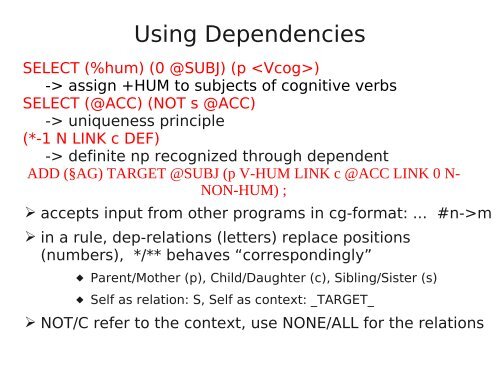On how to write rules in Constraint Grammar (CG-3) - VISL
On how to write rules in Constraint Grammar (CG-3) - VISL
On how to write rules in Constraint Grammar (CG-3) - VISL
You also want an ePaper? Increase the reach of your titles
YUMPU automatically turns print PDFs into web optimized ePapers that Google loves.
Us<strong>in</strong>g Dependencies<br />
SELECT (%hum) (0 @SUBJ) (p )<br />
-> assign +HUM <strong>to</strong> subjects of cognitive verbs<br />
SELECT (@ACC) (NOT s @ACC)<br />
-> uniqueness pr<strong>in</strong>ciple<br />
(*-1 N LINK c DEF)<br />
-> def<strong>in</strong>ite np recognized through dependent<br />
ADD (§AG) TARGET @SUBJ (p V-HUM LINK c @ACC LINK 0 N-<br />
NON-HUM) ;<br />
➢ accepts <strong>in</strong>put from other programs <strong>in</strong> cg-format: ... #n->m<br />
➢ <strong>in</strong> a rule, dep-relations (letters) replace positions<br />
(numbers), */** behaves “correspond<strong>in</strong>gly”<br />
Parent/Mother (p), Child/Daughter (c), Sibl<strong>in</strong>g/Sister (s)<br />
Self as relation: S, Self as context: _TARGET_<br />
➢ NOT/C refer <strong>to</strong> the context, use NONE/ALL for the relations
















